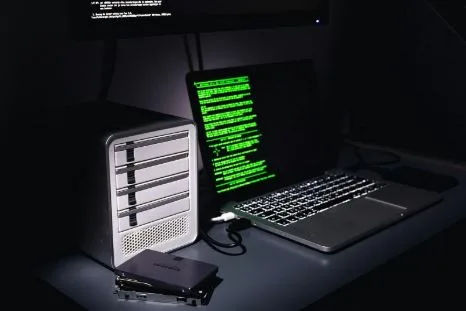Cloud Hosting Security in 2025: What Businesses Must Prioritize
You’re in the office, and an email appears to be from your CFO, casually requesting a wire transfer to close a “time-sensitive deal.” The tone is perfect, the signature matches, but the message was AI-generated.
In 2025, this isn’t rare. Cyber attackers are now using AI to craft highly convincing phishing emails, generate deepfake voice or video messages, and automate exploitation attempts at a scale previously unimaginable. These AI-driven tactics bypass traditional filters and exploit human trust more effectively than ever.
At the same time, cloud platforms essential for modern operations remain high-value targets. As threats evolve faster than legacy defenses, businesses must treat cloud security as a living strategy, not a static checklist..
Why Cloud Security Is More Critical Than Ever in 2025
Cloud platforms now support over 90% of business-critical infrastructure, from customer-facing apps to internal tools. But these systems remain vulnerable.
AI-generated threats like deepfake phishing and real-time exploit chaining surged 67% in 2024.
Meanwhile, supply chain vulnerabilities have grown into daily concerns. One in eight open-source packages has known risks, and adversaries weaponize CI/CD pipelines and APIs to compromise trusted environments.
At the same time, regulatory expectations have tightened. Frameworks like GDPR, NIS2, and SOC 2 now demand continuous compliance, and are no longer confined to annual audits. Maintaining security and audit-readiness in real time is essential.
Top Security Priorities for Businesses
To stay secure in this evolving environment, businesses must focus on the following priorities:
-
Zero Trust Architecture
Strict identity checks and context-based access limit breaches and lateral movement.
-
Real-Time Monitoring and Incident Response
Automated tools paired with tested response playbooks allow teams to neutralize threats before they escalate.
-
Multi-Region Redundancy and Data Replication
Multi-region configurations reroute traffic automatically, keeping critical services available at all times.
-
Compliance with Global Standards
Automating policy enforcement through Infrastructure as Code and CI/CD pipelines ensures continuous alignment with standards like ISO/IEC 27001 and SOC 2, without the last-minute scramble.
-
End-to-End Encryption (At Rest and In Transit)
Leading teams are implementing encryption-in-use to protect sensitive data during processing, essential for AI workflows and financial systems.
-
Access Control and Identity Management (IAM)
Use least-privilege policies, enforce MFA for admins, and audit regularly to prevent privilege creep.
-
Supply Chain Risk Management
Businesses require software bills of materials (SBOMs), block unsigned binaries, and audit dependencies frequently to prevent tampering through the supply chain.
-
Backup and Disaster Recovery Planning
Distributed backups and monthly drills ensure operations bounce back fast.
How Hostman Supports Secure Cloud Hosting
Hostman enables security-first cloud operations by integrating these best practices into its core infrastructure.
- Certified Infrastructure: Hostman runs on ISO/IEC 27001-certified Tier III servers across Europe, North America, and Asia, with high availability, physical security, and global compliance alignment.
- Security by Default: For App deployments, Hostman automatically issues SSL certificates and uses secure Git-based pipelines to ensure integrity and traceability. While these features do not apply to server or database products, they significantly reduce misconfigurations and improve security posture for applications.
- User-Friendly Risk Mitigation: Hostman’s intuitive interface simplifies deployment and helps teams avoid common setup errors that could lead to security issues, especially when working under time pressure.
- Proactive Protection: Hostman’s Infrastructure Scheme provides a complete visual overview of your deployed services and access paths. This makes it easier to identify which components are exposed externally, prioritize them for stronger protection, and ensure nothing is overlooked during security configuration.
Branded Block: What Is Hostman
Hostman is a modern cloud platform designed to simplify the deployment and scaling of digital products while embedding security and compliance at the core.
It supports rapid launches with over 25 ready-to-deploy server configurations and managed databases, including MySQL, PostgreSQL, Redis, Kafka, and OpenSearch. On the App Platform, Git-based workflows enable secure, traceable deployment pipelines, helping teams move code from development to production with greater confidence and visibility.
All infrastructure operates on certified Tier III data centers across Europe, North America, and Asia, ensuring uptime, reliability, and adherence to global standards.
Whether hosting a backend, landing page, or multi-service architecture, Hostman delivers flexibility and protection without enterprise-level overhead.
Final Takeaway
In 2025, cloud security is about sustained readiness, responding to intelligent threats with equally intelligent defense. Businesses that adopt zero trust, automate monitoring, and use secure-by-default platforms will operate with greater resilience.
Hostman brings enterprise-grade protection within reach. By combining encryption, compliance, redundancy, and a simplified user experience, it helps teams stay fast, secure, and prepared for what’s next.
Explore how Hostman’s VPS server hosting helps teams stay fast, secure, and future-ready.






